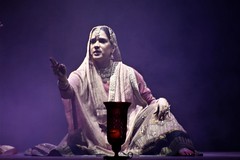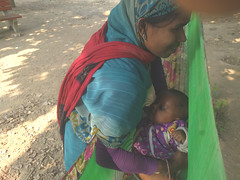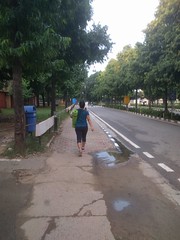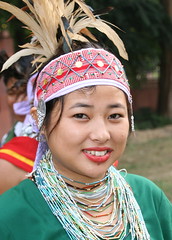Herabai Tata: The Power Behind Indian Women’s Voting Rights
by Rita Banerji
The name Herabai Tata will not ring a bell for most Indians! Unfortunately, not even for most Indian women, even though she is one of the main reasons that women have the right to vote in India!
Born in 1879 in Bombay, Herabai Tata was the Secretary of the Bombay branch of the Women’s Indian Association (WIA). In the early 1900s, she was a central figure in the fight for Indian women’s franchise – the right to vote. In fact she is referred to by Geraldine Forbes who documented the changing lives of Indian women in the early 1900s, as the “real soldier” of the movement.
So why don’t Indian women know of her? The fault perhaps lies with the sexist and patronizing view of the history of women’s rights in school textbooks. Students are taught that it is men who fought for and ‘gave’ women their rights in India.
While there were some male leaders who spoke against sati (the burning alive of widows) and child marriage, often these were attempts to convince a male-dominated society to try to be considerate towards girls and women, by discontinuing these practices. Indeed as prominent feminists even in that period observed these men viewed these ‘rights’ as acts of “charity” towards women, without recognizing women’s inherent rights to live with freedom and dignity.
Indeed, women’s rights are not about women gratefully accepting a benevolent space for living in a society dominated and dictated to by men. It is about the recognition of women as free and equal citizens in society, with the same rights and privileges as men. Incredibly, such a movement for women’s rights existed in India, more than a hundred years ago, and Herabai Tata was one of these women! It was while researching for my book ‘Sex and Power,’ that I discovered with joy and gratitude, these women who comprise what I call India’s first feminist movement. I talk about this movement in the colonial chapter of my book, where I also discuss why with the advent of Gandhi, this movement, was suppressed.
Indeed, the idea of women having inherent and inviolable rights guaranteed under law, and existing as independent citizens with the same power as men to participate in and determine the society they live in and its rules of living, was disagreeable to the most seemingly “progressive” of men of this time. When Herabai and the suffrage movement pushed for Indian women’s right to vote, there was only one man in India who supported them — Sir Sankaran Nair.
Below I present an excerpt from Herabai Tata’s book ‘A Short Sketch of Indian Women’s Franchise Work,’ which gives us an idea of how long and hard the battle for women’s franchise was in India. I believe it is very important for Indian women today to connect with these women from our past, who struggled to ensure that we have the platforms to be free citizens and individuals.
There are other lessons for the present day women’s movement to be learnt from Herabai’s observations. One of the biggest draw backs for women’s rights today is that there is no pan-Indian women’s movement. We are broken up across class, caste, religion and regional boundaries. Yet, a 100 years ago, without good transportation, phone, internet and electricity, Indian women’s groups all over India managed to unite and coordinate their efforts towards a common goal! There were 45 branches of the Women’s Indian Association alone, and many other organizations and committees.
Equally remarkable, I thought, was the networking of women’s groups across continents! One of the biggest allies of the Indian women’s suffrage movement was the British women’s suffrage movement! Together they surmounted the misogynistic hurdles by the British government and Indian male leaders, to ensure women universal franchise in both countries! Herabai’s battle began around 1917. Indian women finally got the right to vote in 1947!
Here is the excerpt from ‘A Short Sketch of Indian Women’s Franchise Work,’ by Herabai Tata.
“[When in 1917] Mr. Montagu, Secretary of State for India, [visited India]…a deputation of Indian women, in which all the Provinces were represented, [met him] and spoke on behalf of their Indian sisters. The chief promoters of this deputation were a group of Indian University women, helped by two ladies who had been ardent workers for the Suffrage in England, Mrs. Margaret Cousins (photo to the right, was Irish) and Mrs. Dorothy Jinarajadasa.
The first demand made by the deputation…was that ‘when the terms of the Indian Franchise were drawn up the word “people” should be understood as including women, and the whole should be worded in such terms as will not disqualify our sex, but allow our women the same opportunities of representation as our men.
The next step came in the form of a resolution in favour women’s suffrage, which was for the first time, placed on the Agenda of the National Congress, held that year at Calcutta. Unfortunately [it] was not brought before the Congress.
In April 1918, the women of Bombay sent a requisition to the Bombay Provincial Conference, asking it to move a resolution in favor of the removal of sex disqualification from the Reform scheme. This reform was moved by an Indian lady, and was carried unanimously.
Similar requisitions were sent by the women of Madras…, the [women of the] Malabar District…,the Provincial Congress Committees of the Bombay and Madras Presidencies, the Central Provinces, Panjab and the United Provinces,..the Andhra Provincial Conference,…[women of] The Muslim League,…women of the [Delhi] Province…These Congresses were the representative bodies of all India…[And] the purpose of all the resolutions is ‘that the word “people” or “persons” should be taken to refer to both men and women, instead of to men alone, and that women should not be put on par with children, foreigners, or lunatics in any scheme of reforms to be given to the country.’ Further, ‘that women possessing the same qualifications as laid down for men in any part of the scheme shall not be disqualified on account of sex.’
[Mr. Montagu] after making his investigations over all parts of [India], drew up…the ‘Montagu-Chelmsford Scheme of Reforms for India.’ [But] no mention of women was made, the question of their rights was just ignored, in spite of the representations and the resolutions passed by the various Conferences and Congresses advocating the giving of the Franchise to Indian women…
[Then] The Southborough Committee was…appointed by the [British] government to [investigate] Indian opinions on the question of Reforms…[to present to] the British Parliament.
The Southborough Committee toured India, and when they visited Bombay, a Requisition signed by about 800 educated women…was submitted to them…asking that women should not excluded from the Franchise proposals.Yet when the Report of The [Southborough] Committee made its appearance in 1919 the claims of Indian women to exercise the power to vote were entirely ignored…It was understood that the members of the Committee based their recommendation on the views they held as to the social customs regarding Indian women…
Only two gentlemen in office upheld the claims of the women—Mr. Hogg, one of the members of the Southborough Committee, and Sir Sankaran Nair, in the Government of India…
In July 1919 the women of Bombay assembled in public meeting to protest against the indignity put upon their sex…[and] protest meetings were also held in other parts of Indian by the combined women’s associations…No less than 11 cablegrams, giving the text of the unanimous resolutions passed at a public protest meeting, were dispatched to prominent persons in England…
[Then] when [in] July 1919, the women in Bombay read the astounding evidence given by Lord Southborough before the Joint Select Committee, to the effect that Indian women do not themselves desire enfranchisement, a meeting was at once called and the following resolution passed, and cabled to the Secretary of State, “Bombay women favouring women’s suffrage have read with pain and surprise Lord Southborough’s evidence before your committee stating franchise to women in India is not desired by women themselves. That belief is not founded on fact. Largely attended Indian women’s meeting recently held in Bombay enthusiastically claimed franchise; similarly various women’s representations were submitted to Southborough Committee. Women ask no favour, but claim right and justice. If the vote is denied it will mean serious check to women’s advancement in India.”
From the 45 branches of the Women’s Indian Association the following cablegram was sent to the Joint Committee: ‘Forty-five branches Women’s Indian Asociations controverts Southborough’s evidence; they claim votes, protest against sex disqualification.’
[There] was immense propaganda work [by] Mrs. Annie Besant…who came to London [in] 1919 to give evidence before the Joint Committee…[and] Mrs. H. A. Tata and Miss M. A. Tata [also went to England] as deputies [of the women of Bombay] with Sir Sankaran Nair. Public meetings were held in many parts of Great Britain and many women’s association in England showed sympathy and took interest in the cause of Indian women.
[Eventually] The Joint Select Committee decided to leave the question of women’s franchise for India to be settled by the future Legislative Councils of India for each Province…
Thus we hope that ere long growing understanding…will hasten the realization that, in India, as in England, responsible and satisfactory Government can only be achieved when men and women, each bear their share in electing their representatives, and give the results of their experience and knowledge in service on public bodies.[Note from Rita Banerji: I have been unable to locate a photo that positively identifies Herabai Tata. The photo in the inset is the only one I’ve found of Indian and British women suffragettes marching together in the UK, but I cannot for sure identify one of them as Herabai Tata, though she was one of the main Indian representatives who went to England and participated in these public rallies. I’d appreciate feedback from anyone who knows.]
© The 50 Million Missing Campaign. All Rights Reserved. To cite, please see ourcopyright guidelines.
ABOUT THE WRITER
Rita Banerji is an author and gender activist, and the founder ofThe 50 Million Missing Campaign to end India’s female genocide. Her book ‘Sex and Power: Defining History Shaping Societies,’ is a historical and social look at how the relationship between gender and power in India has led to the ongoing female gendercide. Her website is www.ritabanerji.com . She blogs at Revolutions in my Space and tweets at @Rita_Banerji

















Reblogged this on auguries14.
Thanks for this superb post. It is very educational. It is very heartwarming to know that Indian and British women identified the common enemy and came together to take on the same.
.Besides the reason you have mentioned reg why we are not taught these in history : history is always written by the winners/the powerful/ruling class. The so-called “mainstream” history I mean. Paraphrasing an African saying : “so long as the lions don’t have their own historians, the hunter will always be the winner”. And the ruling class is vested in brainwashing the public that change always come from above – they don’t want us to be aware that we can collectively bring massive changes by looking past race, gender, caste etc
Reblogged this on iheariseeilearn.
Reblogged this on REVOLUTIONS IN MY SPACE: A BLOG BY RITA BANERJI and commented:
There is a need for women in India to know about and connect with the women in our past, who fought for the rights we legally claim today! Indian textbooks continue to take a stubbornly sexist view of the history of women’s rights in India, insisting that it is men who fought for these rights for women, and edit out even prominent feminists, like Herabai Tata and their works into complete oblivion. We must resurrect the women heroes of our past, and resuscitate the feminist movement they had started in India a 100 years ago!